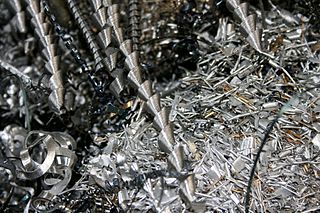From Guest Blogger Dave Fusselman: How Scrap Metal Is Prepared for Conversion into New Products

Material Handler
A variety of equipment is needed to carry out various processing tasks. The first one you would see is the material handler, basically a crane-type machine with an electro-magnet or a grapple that lifts the scrap iron from the delivery vehicle and places it where it can be worked with or shipped out.
This category of scrap is known as “ferrous” metal, meaning it has iron as part of its content. Other elements such as carbon and silicon are added to give the metal desired properties. The electro-magnet will only lift steel, cast iron, and high-nickel alloys. It is useless when handling metals such as copper, aluminum and stainless steel.
The Ferrous Family
One member of the ferrous “family”, cast iron, is typically more porous, allowing it to be broken when enough force is applied to it. It is called “cast” because it is made by pouring molten iron into a mold, then letting it cool and harden. This is called the “casting” process.
Another member, steel, comes out of a melting pot in liquid form also, but as it cools, mechanical pressure is applied to it, often by heavy rollers that compress a red-hot slab into a thinner plate or sheet. That makes steel more pliable – it will bend or tear rather than cleanly break into two pieces.
A scrap iron processing operation uses methods that apply substantial force to cast iron to break it into pieces small enough to be acceptable to foundries.
Shearing
Scrap steel cannot be broken in this way. Various sizes of shears can be used to cut steel into short lengths – the heavier the steel, the larger the shear that will be needed. A stationary shear is a machine that sits on a concrete pad with an upper jaw that opens and closes, pinching the steel against the lower jaw. Sharp blades attached to the jaws cut through the scrap steel like a scissors cuts paper.
A mobile shear mounts to the boom of an excavator-type machine, allowing you to take the shear to the scrap metal. The operator is able to reach into the pile, cut a piece of steel, then swing the shear to a different spot to make another cut on the same piece or another one lying nearby.
Cutting Torch
Whatever a shear cannot cut can be down-sized using a cutting torch. It uses a fuel-gas such as acetylene or propane to heat up the iron to the point of melting, then high-pressure oxygen is blown through the molten steel to create a separation, turning one piece of steel into two smaller pieces. The denseness of steel allows it to be torched in this way, but the larger pores inside cast iron resist this process.
Baling
Scrap steel that is very thin, typically around 1/8” or less, is sometimes run through a baler. Big bulky sheets of siding and roofing from buildings and sheet metal enclosures from machinery can be compacted into a bale weighing 1000# or more, just a few feet long and a couple of feet wide, allowing more product to be loaded onto trucks or railroad cars and subsequently lowering the cost of freight per pound when shipping. Most balers today have a small crane attached where the operator can load the chamber, make a bale, than remove the bale and stack it, all from one seat.
Scrap steel, whether sheared, torched, or baled, is shipped to steel mills to be melted into new products such as beams, rods, plates, angles, channels and pipe.
In summary, there are several different methods used to get scrap iron ready for consumption. The types of scrap received and the level of investment in tools and machinery are the deciding factors for what processes will be used.
Dave Fusselman is the owner of Fusselman Salvage Co. in Moberly, Mo. They are a scrap metal recycler that serves Columbia, Jefferson City, Kirksville, Booneville, Hannibal and many other cities and towns in the North-Central Missouri area.
